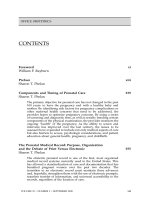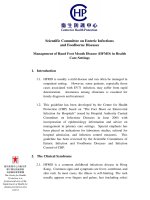Obstetrics and Gynecological Emergencies pot
Bạn đang xem bản rút gọn của tài liệu. Xem và tải ngay bản đầy đủ của tài liệu tại đây (302.41 KB, 15 trang )
10/7/2009
1
Limmer et al., Emergency Care, 11th Edition
© 2009 by Pearson Education, Inc., Upper Saddle River, NJ
DOT
Directory
Chapter 24
Obstetrics and Gynecological
Emergencies
Limmer et al., Emergency Care, 11th Edition
© 2009 by Pearson Education, Inc., Upper Saddle River, NJ
DOT
Directory
U.S. DOT Objectives Directory
U.S. DOT Objectives are covered and/or supported by the PowerPoint™ Slide
Program and Notes for Emergency Care, 11th Ed. Please see the Chapter 24
correlation below.
*KNOWLEDGE AND ATTITUDE
• 4-9.1 Identify the following structures: uterus, vagina, fetus, placenta, umbilical
cord, amniotic sac, perineum. Slides 6-7
• 4-9.2 Identify and explain the use of the contents of an obstetrics kit. Slides 13,
20
• 4-9.3 Identify predelivery emergencies. Slides 17, 57-76
• 4-9.4 State indications of an imminent delivery. Slides 13-16
• 4-9.5 Differentiate the emergency medical care provided to a patient with
predelivery emergencies from a normal delivery. Slides 18, 22-26
• 4-9.6 State the steps in the predelivery preparation of the mother. Slides 19, 21
• 4-9.7 Establish the relationship between body substance isolation (Standard
Precautions) and childbirth. Slide 13
• 4-9.8 State the steps to assist in the delivery. Slides 22-26
• 4-9.9 Describe care of the baby as the head appears. Slides 22-24
(cont.)
Limmer et al., Emergency Care, 11th Edition
© 2009 by Pearson Education, Inc., Upper Saddle River, NJ
DOT
Directory
U.S. DOT Objectives Directory
*KNOWLEDGE AND ATTITUDE
• 4-9.10 Describe how and when to cut the umbilical cord. Slides 27-28
• 4-9.11 Discuss the steps in the delivery of the placenta. Slide 38
• 4-9.12 List the steps in the emergency medical care of the mother postdelivery.
Slides 39-40
• 4-9.13 Summarize neonatal resuscitation procedures. Slides 30-35
• 4-9.14 Describe the procedures for the following abnormal deliveries: breech
birth, prolapsed cord, limb presentation. Slides 9, 42-49
• 4-9.15 Differentiate the special considerations for multiple births. Slides 42, 50-
52
• 4-9.16 Describe special considerations of meconium. Slides 42, 55-56
• 4-9.17 Describe the special considerations of a premature baby. Slides 42, 53-
54
• 4-9.18 Discuss the emergency medical care of a patient with a gynecological
emergency. Slides 78-81
• 4-9.19 Explain the rationale for understanding the implications of treating two
patients (mother and baby). Slides 39-40
(cont.)
Limmer et al., Emergency Care, 11th Edition
© 2009 by Pearson Education, Inc., Upper Saddle River, NJ
DOT
Directory
U.S. DOT Objectives Directory
*SKILLS
• 4-9.20 Demonstrate the steps to assist in the normal cephalic delivery.
• 4-9.21 Demonstrate necessary care procedures of the fetus as the head
appears.
• 4-9.22 Demonstrate infant neonatal procedures.
• 4-9.23 Demonstrate postdelivery care of the infant.
• 4-9.24 Attend to the steps in the delivery of the placenta.
• 4-9.25 Demonstrate the procedures for the following abnormal deliveries:
vaginal bleeding, breech birth, prolapsed cord, limb presentation.
• 4-9.26 Demonstrate the steps in the emergency medical care of the mother
with excessive bleeding.
• 4-9.27 Demonstrate completing a prehospital care report for patients with
obstetrical/gynecological emergencies.
Limmer et al., Emergency Care, 11th Edition
© 2009 by Pearson Education, Inc., Upper Saddle River, NJ
DOT
Directory
Care of the Mother
Before Delivery
Limmer et al., Emergency Care, 11th Edition
© 2009 by Pearson Education, Inc., Upper Saddle River, NJ
DOT
Directory
Anatomy
Fetus—developing baby
Uterus—a muscular organ also called
the womb
Cervix—the neck of the uterus
Vagina—canal
Placenta—attached to the wall of the
uterus and is composed of maternal
and fetal tissues
(cont.)
10/7/2009
2
Limmer et al., Emergency Care, 11th Edition
© 2009 by Pearson Education, Inc., Upper Saddle River, NJ
DOT
Directory
Anatomy
Limmer et al., Emergency Care, 11th Edition
© 2009 by Pearson Education, Inc., Upper Saddle River, NJ
DOT
Directory
Stages of Pregnancy
1st trimester (1st–3rd months)
– Fetus is being formed
2nd trimester (5th month)
– Uterus grows rapidly, reaching the
umbilicus
3rd trimester (7th month)
– Uterus now reaches the epigastrium
Limmer et al., Emergency Care, 11th Edition
© 2009 by Pearson Education, Inc., Upper Saddle River, NJ
DOT
Directory
Types of Presentation
Cephalic
– Normal, head-first birth
Breech
– Buttocks or both feet deliver first
Limmer et al., Emergency Care, 11th Edition
© 2009 by Pearson Education, Inc., Upper Saddle River, NJ
DOT
Directory
Stages of Labor
Click the image to zoom.
Limmer et al., Emergency Care, 11th Edition
© 2009 by Pearson Education, Inc., Upper Saddle River, NJ
DOT
Directory
Labor Pains
Ache in lower back
Pain in lower abdomen, with
increased intensity
Regular intervals
Limmer et al., Emergency Care, 11th Edition
© 2009 by Pearson Education, Inc., Upper Saddle River, NJ
DOT
Directory
Delivery
10/7/2009
3
Limmer et al., Emergency Care, 11th Edition
© 2009 by Pearson Education, Inc., Upper Saddle River, NJ
DOT
Directory
Equipment
Surgical gloves, scissors
Towels, sheets, baby blanket
Gauze pads
Sanitary napkins
Towel or plastic bag
Sterile disposable gloves, eye wear
Limmer et al., Emergency Care, 11th Edition
© 2009 by Pearson Education, Inc., Upper Saddle River, NJ
DOT
Directory
Pre-delivery Evaluation
Name, age, due date?
First pregnancy?
Contractions or pain? Onset?
Bleeding or discharge?
– Meconium staining
Crowning?
Limmer et al., Emergency Care, 11th Edition
© 2009 by Pearson Education, Inc., Upper Saddle River, NJ
DOT
Directory
Evaluation of Labor Pains
Contraction interval or frequency
Contraction time or duration
Feel the urge to move bowels
Feel the need to push
Rock-hard abdomen
Limmer et al., Emergency Care, 11th Edition
© 2009 by Pearson Education, Inc., Upper Saddle River, NJ
DOT
Directory
Transport Decision
Based on assessment
– Birth imminent if contractions less than
2 minutes apart
Number of prior births
Distance to hospital
Limmer et al., Emergency Care, 11th Edition
© 2009 by Pearson Education, Inc., Upper Saddle River, NJ
DOT
Directory
Supine Hypotensive Syndrome
Dizziness and drop in blood
pressure
Referred to as vena cava
compression syndrome
Decreased blood return leads to
drop in BP and shock
Limmer et al., Emergency Care, 11th Edition
© 2009 by Pearson Education, Inc., Upper Saddle River, NJ
DOT
Directory
Treatment of Hypotension
Transport on left side
Pillow or rolled blanket behind back
10/7/2009
4
Limmer et al., Emergency Care, 11th Edition
© 2009 by Pearson Education, Inc., Upper Saddle River, NJ
DOT
Directory
Preparing for Delivery
Patient privacy
Standard Precautions
Position mother on bed, floor, or
ambulance stretcher
Remove clothing
Position your assistant
Position equipment near patient
Limmer et al., Emergency Care, 11th Edition
© 2009 by Pearson Education, Inc., Upper Saddle River, NJ
DOT
Directory
OB Kit
Limmer et al., Emergency Care, 11th Edition
© 2009 by Pearson Education, Inc., Upper Saddle River, NJ
DOT
Directory
Delivering the Baby
Limmer et al., Emergency Care, 11th Edition
© 2009 by Pearson Education, Inc., Upper Saddle River, NJ
DOT
Directory
Normal Delivery
DO NOT PULL ON THE BABY!
If the amniotic sac has not
broken by the time the
baby’s head is delivered,
use your finger to
puncture the membrane.
Limmer et al., Emergency Care, 11th Edition
© 2009 by Pearson Education, Inc., Upper Saddle River, NJ
DOT
Directory
Checking for Umbilical Cord
Limmer et al., Emergency Care, 11th Edition
© 2009 by Pearson Education, Inc., Upper Saddle River, NJ
DOT
Directory
Delivery Steps
Suction
mouth,
then nose
Assist with
upper
shoulders
(cont.)
10/7/2009
5
Limmer et al., Emergency Care, 11th Edition
© 2009 by Pearson Education, Inc., Upper Saddle River, NJ
DOT
Directory
Delivery Steps
Support
the trunk
Support
the torso
& legs
(cont.)
Limmer et al., Emergency Care, 11th Edition
© 2009 by Pearson Education, Inc., Upper Saddle River, NJ
DOT
Directory
Delivery Steps
Wrap baby in warm towel, head lower than trunk
Warmth is critical!
Suction again
Wipe blood and mucus from nose and mouth
Limmer et al., Emergency Care, 11th Edition
© 2009 by Pearson Education, Inc., Upper Saddle River, NJ
DOT
Directory
Post Delivery
Same level as
mother
Wait for
pulsating to
stop
Clamp and cut
umbilical cord
Note exact time
of birth
Limmer et al., Emergency Care, 11th Edition
© 2009 by Pearson Education, Inc., Upper Saddle River, NJ
DOT
Directory
Cutting the Umbilical Cord
Infant warm
Sterile clamps or umbilical tape
1st clamp 10 inches
2nd clamp 7 inches
Cut between clamps
Limmer et al., Emergency Care, 11th Edition
© 2009 by Pearson Education, Inc., Upper Saddle River, NJ
DOT
Directory
Care of the Newly Born
Limmer et al., Emergency Care, 11th Edition
© 2009 by Pearson Education, Inc., Upper Saddle River, NJ
DOT
Directory
Care of the Newly Born
10/7/2009
6
Limmer et al., Emergency Care, 11th Edition
© 2009 by Pearson Education, Inc., Upper Saddle River, NJ
DOT
Directory
Assessment—Newly Born
Breathing, heart rate, crying,
movement, skin color
Pulse greater than 100 bpm
Vigorous crying
Moving extremities
Blue coloration hands and feet ONLY
Reassess after 5 minutes
Limmer et al., Emergency Care, 11th Edition
© 2009 by Pearson Education, Inc., Upper Saddle River, NJ
DOT
Directory
Resuscitation—Newly Born
Assess heart rate, respirations & color
Establish breathing
Suction
Warmth & clear airway
Limmer et al., Emergency Care, 11th Edition
© 2009 by Pearson Education, Inc., Upper Saddle River, NJ
DOT
Directory
Respirations
Newborn should begin
breathing within 30
seconds
Provide only small puffs
of air if using mouth to
mask
Rate of 40 to 60 per
minute
Adequate respirations
and a pulse rate greater
than 100 per minute
– Supplemental oxygen
Limmer et al., Emergency Care, 11th Edition
© 2009 by Pearson Education, Inc., Upper Saddle River, NJ
DOT
Directory
Heart Rate
Heart rate less than 100 beats per
minute
– Ventilate at a rate of 40 to 60 per minute
Heart rate is less than 60 beats per
minute
– Initiate chest compressions
Rate of 120 compressions per minute
3:1 ratio of compressions to
respirations
90 compressions and 30 ventilations per
minute
Limmer et al., Emergency Care, 11th Edition
© 2009 by Pearson Education, Inc., Upper Saddle River, NJ
DOT
Directory
Stimulation
Gentle but vigorous
rubbing of the baby’s
back
Do not hold the baby
up by his feet and slap
his bottom.
It is not uncommon for
this blue color to
remain for the first few
minutes.
Limmer et al., Emergency Care, 11th Edition
© 2009 by Pearson Education, Inc., Upper Saddle River, NJ
DOT
Directory
Cultural Considerations
Be sensitive to various ethnic,
cultural, and religious groups
regarding child birth.
If possible, allow time for family to
respond to the birth.
10/7/2009
7
Limmer et al., Emergency Care, 11th Edition
© 2009 by Pearson Education, Inc., Upper Saddle River, NJ
DOT
Directory
Care of the Mother
After Delivery
Limmer et al., Emergency Care, 11th Edition
© 2009 by Pearson Education, Inc., Upper Saddle River, NJ
DOT
Directory
Delivery of the Placenta
Labor pains
Lengthening of cord
Process may take longer than 30
minutes.
Transport can be delayed.
Place in a container and label.
Limmer et al., Emergency Care, 11th Edition
© 2009 by Pearson Education, Inc., Upper Saddle River, NJ
DOT
Directory
Caring for the Mother
Observe for
delivery of
placenta.
When placenta
delivers, place in
plastic bag for
transport to
hospital.
© Fred McConnaughey/Photo Researchers, Inc.
Limmer et al., Emergency Care, 11th Edition
© 2009 by Pearson Education, Inc., Upper Saddle River, NJ
DOT
Directory
Control Vaginal Bleeding
Place sanitary napkin over vagina.
Position mother’s legs lowered and
together.
Massage the uterus.
Nurse the baby.
Treat torn perineum as a wound.
Limmer et al., Emergency Care, 11th Edition
© 2009 by Pearson Education, Inc., Upper Saddle River, NJ
DOT
Directory
Childbirth Complications
Limmer et al., Emergency Care, 11th Edition
© 2009 by Pearson Education, Inc., Upper Saddle River, NJ
DOT
Directory
Childbirth Complications
Breech presentation
Prolapsed cord
Limb presentation
Multiple births
Premature birth
Meconium
10/7/2009
8
Limmer et al., Emergency Care, 11th Edition
© 2009 by Pearson Education, Inc., Upper Saddle River, NJ
DOT
Directory
Most common
abnormal delivery
Buttocks first or
both legs first
Increased risk of
prolapsed cord
Possible
meconium staining
Breech Presentation
Limmer et al., Emergency Care, 11th Edition
© 2009 by Pearson Education, Inc., Upper Saddle River, NJ
DOT
Directory
Patient Care—Breech
Presentation
Provide care for baby, cord, mother, and placenta.
If body delivers, support it.
Position mother in head-down position.
Provide high-flow oxygen.
Never attempt to pull legs.
Transport rapidly.
Provide high-concentration oxygen.
Limmer et al., Emergency Care, 11th Edition
© 2009 by Pearson Education, Inc., Upper Saddle River, NJ
DOT
Directory
Prolapsed Cord
Position mother head down and
buttocks raised.
Provide high-concentration oxygen.
Check for pulses and wrap cord.
Insert several fingers into vagina to
push up on baby’s head.
Transport.
(cont.)
Limmer et al., Emergency Care, 11th Edition
© 2009 by Pearson Education, Inc., Upper Saddle River, NJ
DOT
Directory
Prolapsed Cord
Limmer et al., Emergency Care, 11th Edition
© 2009 by Pearson Education, Inc., Upper Saddle River, NJ
DOT
Directory
Limb Presentation
Limb protrudes
from vagina
Commonly a foot
or arm
Cannot be
delivered in
prehospital
Rapid transport
Limmer et al., Emergency Care, 11th Edition
© 2009 by Pearson Education, Inc., Upper Saddle River, NJ
DOT
Directory
Assessment—Limb Presentation
Look for
crowning
Arm or leg
Arm and leg
together
Shoulder and
arm
10/7/2009
9
Limmer et al., Emergency Care, 11th Edition
© 2009 by Pearson Education, Inc., Upper Saddle River, NJ
DOT
Directory
Patient Care—Limb Presentation
High flow oxygen
Mother in head down position
Transport mother
Keep baby off cord
High-concentration oxygen
Limmer et al., Emergency Care, 11th Edition
© 2009 by Pearson Education, Inc., Upper Saddle River, NJ
DOT
Directory
Multiple Births
More than one baby born during single
delivery
Twins not considered complication
Call for assistance.
Limmer et al., Emergency Care, 11th Edition
© 2009 by Pearson Education, Inc., Upper Saddle River, NJ
DOT
Directory
Assessment—Multiple Births
Mother should be aware.
Abdomen appears unusually large.
Multiple contractions
Limmer et al., Emergency Care, 11th Edition
© 2009 by Pearson Education, Inc., Upper Saddle River, NJ
DOT
Directory
Patient Care—Multiple Births
Provide care.
2
nd
baby either before or after placenta
Clamp or tie cord of 1
st
baby,
before the 2
nd
is born.
Limmer et al., Emergency Care, 11th Edition
© 2009 by Pearson Education, Inc., Upper Saddle River, NJ
DOT
Directory
Premature Birth
Infant weighs < 5-1/2 lbs (2.5 kgs)
Born before 37th week
Assessment
– Full term vs. premature
– Head is larger
Limmer et al., Emergency Care, 11th Edition
© 2009 by Pearson Education, Inc., Upper Saddle River, NJ
DOT
Directory
Patient Care—Premature Birth
Transport in warm ambulance
Avoid contamination
Provide oxygen
Watch for umbilical cord bleeding
Provide ventilations, as needed
Keep airway clear
Keep baby warm
10/7/2009
10
Limmer et al., Emergency Care, 11th Edition
© 2009 by Pearson Education, Inc., Upper Saddle River, NJ
DOT
Directory
Meconium
Results from fetus defecating
Sign of fetal or maternal distress
Assessment
– Amniotic fluid greenish or brownish-
yellow
– Risk for respiratory problems
Limmer et al., Emergency Care, 11th Edition
© 2009 by Pearson Education, Inc., Upper Saddle River, NJ
DOT
Directory
Patient Care—Meconium
Transport.
Provide ventilations and/or chest compressions.
Maintain open airway.
Suction mouth then nose.
Reduce risk of aspiration.
Limmer et al., Emergency Care, 11th Edition
© 2009 by Pearson Education, Inc., Upper Saddle River, NJ
DOT
Directory
Emergencies in Pregnancy
Pre-birth Bleeding
Ectopic Pregnancy
Seizures
Miscarriage and Abortion
Trauma
Stillbirths
Limmer et al., Emergency Care, 11th Edition
© 2009 by Pearson Education, Inc., Upper Saddle River, NJ
DOT
Directory
Placenta Previa
Placenta in
abnormal
position
Tearing of
placenta
May occur in
3rd trimester
Limmer et al., Emergency Care, 11th Edition
© 2009 by Pearson Education, Inc., Upper Saddle River, NJ
DOT
Directory
Abruptio Placentae
Placenta
separates from
uterine wall
Partial or
complete
Life threatening
May occur in the
3rd trimester
Limmer et al., Emergency Care, 11th Edition
© 2009 by Pearson Education, Inc., Upper Saddle River, NJ
DOT
Directory
Ruptured Uterus
As the uterus
enlarges
throughout
pregnancy,
the uterine wall
becomes
extremely thin and is
prone to spontaneous
or traumatic rupture
10/7/2009
11
Limmer et al., Emergency Care, 11th Edition
© 2009 by Pearson Education, Inc., Upper Saddle River, NJ
DOT
Directory
Signs and Symptoms
Main sign—profuse bleeding
Associated abdominal pain
Shock
Rapid heartbeat
Limmer et al., Emergency Care, 11th Edition
© 2009 by Pearson Education, Inc., Upper Saddle River, NJ
DOT
Directory
Patient Care—Excessive
Bleeding
Save tissue.
Sanitary napkin over vagina
Signs of shock — high concentration of oxygen
Limmer et al., Emergency Care, 11th Edition
© 2009 by Pearson Education, Inc., Upper Saddle River, NJ
DOT
Directory
Ectopic Pregnancy
Normal pregnancy—egg divides in the
oviduct (fallopian tube)
Ectopic pregnancy—egg implanted
outside the uterus
Acute abdominal pain
Vaginal bleeding
Rapid and weak pulse (later sign)
Low blood pressure (a very late sign)
(cont.)
Limmer et al., Emergency Care, 11th Edition
© 2009 by Pearson Education, Inc., Upper Saddle River, NJ
DOT
Directory
Ectopic Pregnancy
Limmer et al., Emergency Care, 11th Edition
© 2009 by Pearson Education, Inc., Upper Saddle River, NJ
DOT
Directory
Patient Care: Ectopic Pregnancy
Nothing by mouth
Care for shock
Position the patient for shock
Consider the need for immediate transport
Limmer et al., Emergency Care, 11th Edition
© 2009 by Pearson Education, Inc., Upper Saddle River, NJ
DOT
Directory
Seizures in Pregnancy
Preeclampsia
– Swelling of extremities
Eclampsia
– Occurs late in pregnancy
Assessment
– Elevated BP
– Excessive weight gain
– Swelling of face and extremities
– Headache
10/7/2009
12
Limmer et al., Emergency Care, 11th Edition
© 2009 by Pearson Education, Inc., Upper Saddle River, NJ
DOT
Directory
Patient Care—Seizures
Maintain warmth.
Handle gently.
Transport.
Give high-concentration oxygen.
Open airway.
Limmer et al., Emergency Care, 11th Edition
© 2009 by Pearson Education, Inc., Upper Saddle River, NJ
DOT
Directory
Miscarriage and Abortion
Delivery before 28th week
Called spontaneous abortion or
miscarriage
Induced abortion
– Results from deliberate actions to stop
pregnancy
Limmer et al., Emergency Care, 11th Edition
© 2009 by Pearson Education, Inc., Upper Saddle River, NJ
DOT
Directory
Signs and Symptoms
Cramping abdominal pains
– Associated with 1st stage of labor
Bleeding
– Moderate
– Severe
Discharge
– Tissue
– Blood
Limmer et al., Emergency Care, 11th Edition
© 2009 by Pearson Education, Inc., Upper Saddle River, NJ
DOT
Directory
Patient Care—Miscarriage
Emotional support
Save tissues
Transport
Control bleeding
Oxygen
Vital signs
Limmer et al., Emergency Care, 11th Edition
© 2009 by Pearson Education, Inc., Upper Saddle River, NJ
DOT
Directory
Trauma in Pregnancy
Blunt or penetrating
– Automobile collisions
– Falls
– Assault
Greatest danger
– Hemorrhage
– Shock
Limmer et al., Emergency Care, 11th Edition
© 2009 by Pearson Education, Inc., Upper Saddle River, NJ
DOT
Directory
Patient Assessment—Trauma
Pulse 10–15 bpm faster than normal
Blood volume increased
Shock
Consider trauma
Bleeding or wetness
Mechanism of injury
10/7/2009
13
Limmer et al., Emergency Care, 11th Edition
© 2009 by Pearson Education, Inc., Upper Saddle River, NJ
DOT
Directory
Patient Care—Trauma
in Pregnancy
Emotional support
Transport
Suction
Oxygen
Provide resuscitation
Limmer et al., Emergency Care, 11th Edition
© 2009 by Pearson Education, Inc., Upper Saddle River, NJ
DOT
Directory
Stillbirths
Baby dies in the womb
Continue resuscitation
Records
Limmer et al., Emergency Care, 11th Edition
© 2009 by Pearson Education, Inc., Upper Saddle River, NJ
DOT
Directory
Patient Assessment—Stillbirth
Obvious blisters
Foul odor
Skin or tissue deterioration and
discoloration
Softened head
Cardiac or pulmonary arrest
Limmer et al., Emergency Care, 11th Edition
© 2009 by Pearson Education, Inc., Upper Saddle River, NJ
DOT
Directory
Patient Care—Stillbirth
Obviously dead
– No resuscitation
Pulmonary or cardiac arrest
– Basic life support
Imminent death
– Prepare to provide life support.
Limmer et al., Emergency Care, 11th Edition
© 2009 by Pearson Education, Inc., Upper Saddle River, NJ
DOT
Directory
Gynecological Emergencies
Limmer et al., Emergency Care, 11th Edition
© 2009 by Pearson Education, Inc., Upper Saddle River, NJ
DOT
Directory
Gynecological Emergencies
Vaginal bleeding
Sexual assault
10/7/2009
14
Limmer et al., Emergency Care, 11th Edition
© 2009 by Pearson Education, Inc., Upper Saddle River, NJ
DOT
Directory
Patient Care—Vaginal Bleeding
Transport
High concentration oxygen
Assess for signs of shock
Ensure adequate airway
Standard Precautions
Limmer et al., Emergency Care, 11th Edition
© 2009 by Pearson Education, Inc., Upper Saddle River, NJ
DOT
Directory
Trauma to External Genitalia
Observe mechanisms of injury
Signs of severe blood loss and
shock
Control bleeding with direct
pressure
Oxygen
Professional attitude
Respect patient privacy
Limmer et al., Emergency Care, 11th Edition
© 2009 by Pearson Education, Inc., Upper Saddle River, NJ
DOT
Directory
Sexual Assault
Scene safety
Identify and treat medical and
psychological needs.
Provide open airway.
Do not disturb evidence.
Examine genitals ONLY if severe
bleeding.
Discourage from bathing.
Report as required.
Limmer et al., Emergency Care, 11th Edition
© 2009 by Pearson Education, Inc., Upper Saddle River, NJ
DOT
Directory
Review Questions
1. Name and describe the anatomical
structures of a woman’s body that
are associated with pregnancy.
2. Describe the three stages of labor.
3. Explain how to evaluate and to
prepare the mother for delivery.
(cont.)
Limmer et al., Emergency Care, 11th Edition
© 2009 by Pearson Education, Inc., Upper Saddle River, NJ
DOT
Directory
Review Questions
4. Name, in the order of the inverted
pyramid, the steps that may be
taken to resuscitate a newborn
infant.
5. Name and describe several
possible complications of delivery.
6. Name and describe several
possible predelivery emergencies.
Limmer et al., Emergency Care, 11th Edition
© 2009 by Pearson Education, Inc., Upper Saddle River, NJ
DOT
Directory
Street Scenes
What should be the first priority when
entering the scene?
Should ALS assistance be requested?
What questions should you ask the
mother or the father?
(cont.)
10/7/2009
15
Limmer et al., Emergency Care, 11th Edition
© 2009 by Pearson Education, Inc., Upper Saddle River, NJ
DOT
Directory
Street Scenes
What immediate care should be
provided to the newborn?
What care should your partner be
giving to the mother?
Limmer et al., Emergency Care, 11th Edition
© 2009 by Pearson Education, Inc., Upper Saddle River, NJ
DOT
Directory
Sample Documentation









